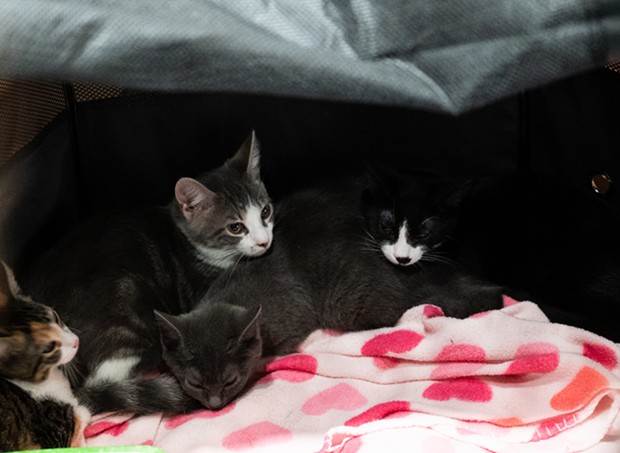
Perusing Trash Cat Rescue’s adoptable animals, you’re likely to find some colorful names. Currently listed are Bulldozer and Dump Truck, three-month old tabico kittens; Gargoyle, a black “catten” rescued from an outdoor colony; and Scott “Scotty” Pilgrim (presumably named for the 2010 Michael Cera film), a dark brown tabby and “shy boy.”
All the rescued kitties fall under the label of “trash cat,” but, as co-founders Danielle Walendziewicz and Alysa McNearney tell Pittsburgh City Paper, they wear it lightly. It insteads serves as an affectionate nod to the animals’ “unglamorous” origins and to the mission of the Gibsonia-based rescue, this year’s winner for Best Place to Adopt a Pet in our Best of PGH readers' poll.
“[The cats] are not found in good condition,” explains McNearney, who says animals are often discovered flea- or mite-ridden and literally in the trash. “So [it’s this] aesthetic of, we found this trashy, dirty, poor-condition animal and then we turn it into the nice forever pet that you want to have.”
Walendziewicz met McNeary while working at the former Animal Rescue League of Western Pennsylvania (now Humane Animal Rescue) as a veterinary technician. McNeary, who was fostering cats and photographing adoptable pets, first helped Walendziewicz with an elusive outdoor cat who kept having litters of “really spicy kittens.” McNeary helped foster the kittens while the pair humanely trapped their mother, brought her to a veterinarian to be spayed, then released her back outside — a method known as Trap-Neuter-Return (TNR), which helps stabilize community cat populations.
Around the same time, McNeary fostered a cat named Possum, who was found inside a Dumpster.“He came in with an ear tip. His intake photo was of him with his ears just totally flattened,” McNeary remembers. “And he was sitting in his litter box looking pathetic.”

She made an Instagram post calling Possum “my little trash cat” and “people went crazy over it,” McNeary says. “So it kind of just stuck.”
Trash Cat Rescue officially formed in July 2021 under the three pillars of its mission — TNR, fostering, and adoption. In its first year, the rescue successfully adopted out 365 cats — surprising McNeary at “almost a cat a day” — and is on track to reach the same number this year. The nonprofit has also neutered and released 64 cats since its founding.
Currently, Trash Cat works with a network of 30 foster homes, but they’ve “tossed the idea around lightly” of opening a brick-and-mortar shelter, Walendziewicz says.
The pair believes the idea of a “trash cat” connects so strongly with pet lovers because it gives the rescue an “edge,” and because of its honesty.
“It definitely gives a better representation than, like, Angel Paws,” Walendziewic says. (McNeary notes her own mother is still skeptical of the name.)

They try to lead with acceptance, Walendziewic says, from thanking individual donors to approaching a recent hoarding situation rescue without judgment — and they encourage people who see a cat in need to do the same.
“Nine times out of 10, you have the capability to help that animal,” McNeary says. “Once you see the need around you, you can’t unsee it.”
Trash Cat Rescue. trashcatrescue.org


